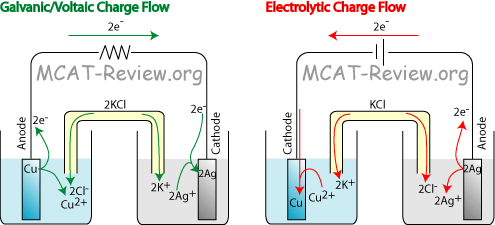Electrolysis
Key Questions
-
Thanks for your question regarding electrolytic cells.
A galvanic cell runs spontaneously. You have two different electrodes and one has a higher reduction potential than the other. Electrons will flow from the electrode that is harder to reduce (the anode) to the electrode that is easier to reduce (the cathode). A galvanic cell is a device which changes chemical energy to electrical energy.
An electrolytic cell uses electrical energy to produce a chemical change. An electrolytic cell is NOT spontaneous. It requires electrical energy (like a battery or a power source) for the reaction to occur. This added energy forces the electrons to flow opposite to nature.
Electrolysis is very useful. Some examples of where it is used is in charging batteries, coating metals with less chemically reactive metals (like gold and silver plating), and isolating metals like aluminum from ores.
I tried to add a link showing you visuals, but it didn't work. Search electrolytic and galvanic cells and images.
Good luck!
-
Electrochemical cells convert chemical energy to electrical, producing an electric current with a potential.
For example, a copper/silver electrochemical cell produces a positive cell potential.
The electrical current flowing in the external circuit can do work. Copper goes into solution as Cu²⁺ ions, and Ag⁺ ions plate out as metallic silver.

Electrolysis converts electrical energy to chemical, requiring an electric current.
If you use a battery to reverse the current flow, the silver goes into solution as Ag⁺ ions, and the Cu²⁺ ions plate out as copper metal.
-
In chemistry and manufacturing, electrolysis is a method of using a direct electric current (DC) to drive an otherwise non-spontaneous chemical reaction.
Electrolysis is commercially highly important as a stage in the separation of elements from naturally occurring sources such as ores using an electrolytic cell. The voltage that is needed for electrolysis to occur is called decomposition potential.
Electrolysis is the passage of a direct electric current through an ionic substance that is either molten or dissolved in a suitable solvent, resulting in chemical reactions at the electrodes and separation of materials.
The main components required to achieve electrolysis are :
An electrolyte: a substance containing free ions which are the carriers of electric current in the electrolyte. If the ions are not mobile, as in a solid salt then electrolysis cannot occur.
A direct current (DC) supply : provides the energy necessary to create or discharge the ions in the electrolyte. Electric current is carried by electrons in the external circuit.
Two electrodes : an electrical conductor which provides the physical interface between the electrical circuit providing the energy and the electrolyte.